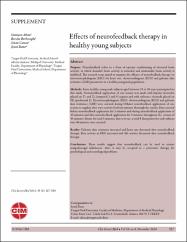| dc.contributor.author | Altan, Sümeyra | |
| dc.contributor.author | Berberoğlu, Bercim | |
| dc.contributor.author | Canan, Sinan | |
| dc.contributor.author | Dane, Şenol | |
| dc.date.accessioned | 10.07.201910:49:13 | |
| dc.date.accessioned | 2019-07-10T19:37:20Z | |
| dc.date.available | 10.07.201910:49:14 | |
| dc.date.available | 2019-07-10T19:37:20Z | |
| dc.date.issued | 2016 | en_US |
| dc.identifier.citation | Altan, S., Berberoğlu, B., Canan, S. ve Dane, Ş. (2016). Effects of neurofeedback therapy in healthy young subjects. Clinical and Investigative Medicine, 39(6), S27-S30. | en_US |
| dc.identifier.issn | 0147-958X | |
| dc.identifier.uri | https://hdl.handle.net/20.500.12511/1383 | |
| dc.description.abstract | Purpose: Neurofeedback refers to a form of operant conditioning of electrical brain activity, in which desirable brain activity is rewarded and undesirable brain activity is inhibited. The research team aimed to examine the efficacy of neurofeedback therapy on electroencephalogram (EEG) for heart rate, electrocardiogram (ECG) and galvanic skin resistance (GSR) parameters in a healthy young male population. Methods: Forty healthy young male subjects aged between 18 to 30 years participated in this study. Neurofeedback application of one session was made with bipolar electrodes placed on T3 and T4 (temporal 3 and 4) regions and with reference electrode placed on PF1 (prefrontal 1). Electroencephalogram (EEG), electrocardiogram (ECG) and galvanic skin resistance (GSR) were assessed during Othmer neurofeedback application of one session to regulate slow wave activity for forty minutes thorough the session. Data assessed before neurofeedback application for 5 minutes and during neurofeedback application of 30 minutes and after neurofeedback application for 5 minutes throughout the session of 40 minutes. Means for each 5 minutes, that is to say, a total 8 data points for each subjects over 40 minutes, were assessed. Results: Galvanic skin resistance increased and heart rate decreased after neurofeedback therapy. Beta activity in EEG increased and alfa activity decreased after neurofeedback therapy. Conclusions: These results suggest that neurofeedback can be used to restore sympathovagal imbalances. Also, it may be accepted as a preventive therapy for psychological and neurological problems. | en_US |
| dc.language.iso | eng | en_US |
| dc.publisher | The Canadian Society for Clinical Investigation | en_US |
| dc.rights | info:eu-repo/semantics/openAccess | en_US |
| dc.subject | Efects of Neurofeedback | en_US |
| dc.subject | Therapy | en_US |
| dc.subject | Healthy Young Subjects | en_US |
| dc.title | Effects of neurofeedback therapy in healthy young subjects | en_US |
| dc.type | article | en_US |
| dc.relation.ispartof | Clinical and Investigative Medicine | en_US |
| dc.department | İstanbul Medipol Üniversitesi, Tıp Fakültesi, Temel Tıp Bilimleri Bölümü, Fizyoloji Ana Bilim Dalı | en_US |
| dc.identifier.volume | 39 | en_US |
| dc.identifier.issue | 6 | en_US |
| dc.identifier.startpage | S27 | en_US |
| dc.identifier.endpage | S30 | en_US |
| dc.relation.publicationcategory | Makale - Uluslararası Hakemli Dergi - Kurum Öğretim Elemanı | en_US |
| dc.identifier.wosquality | Q4 | en_US |
| dc.identifier.scopusquality | Q2 | en_US |


















